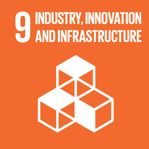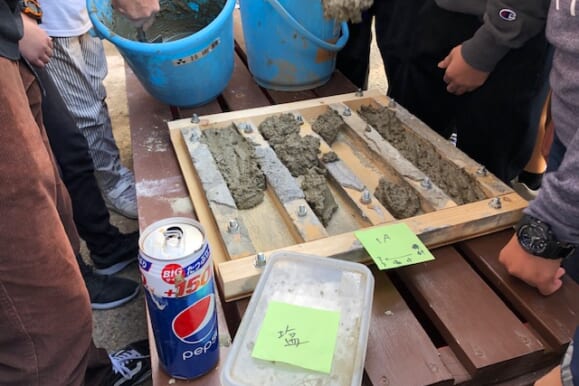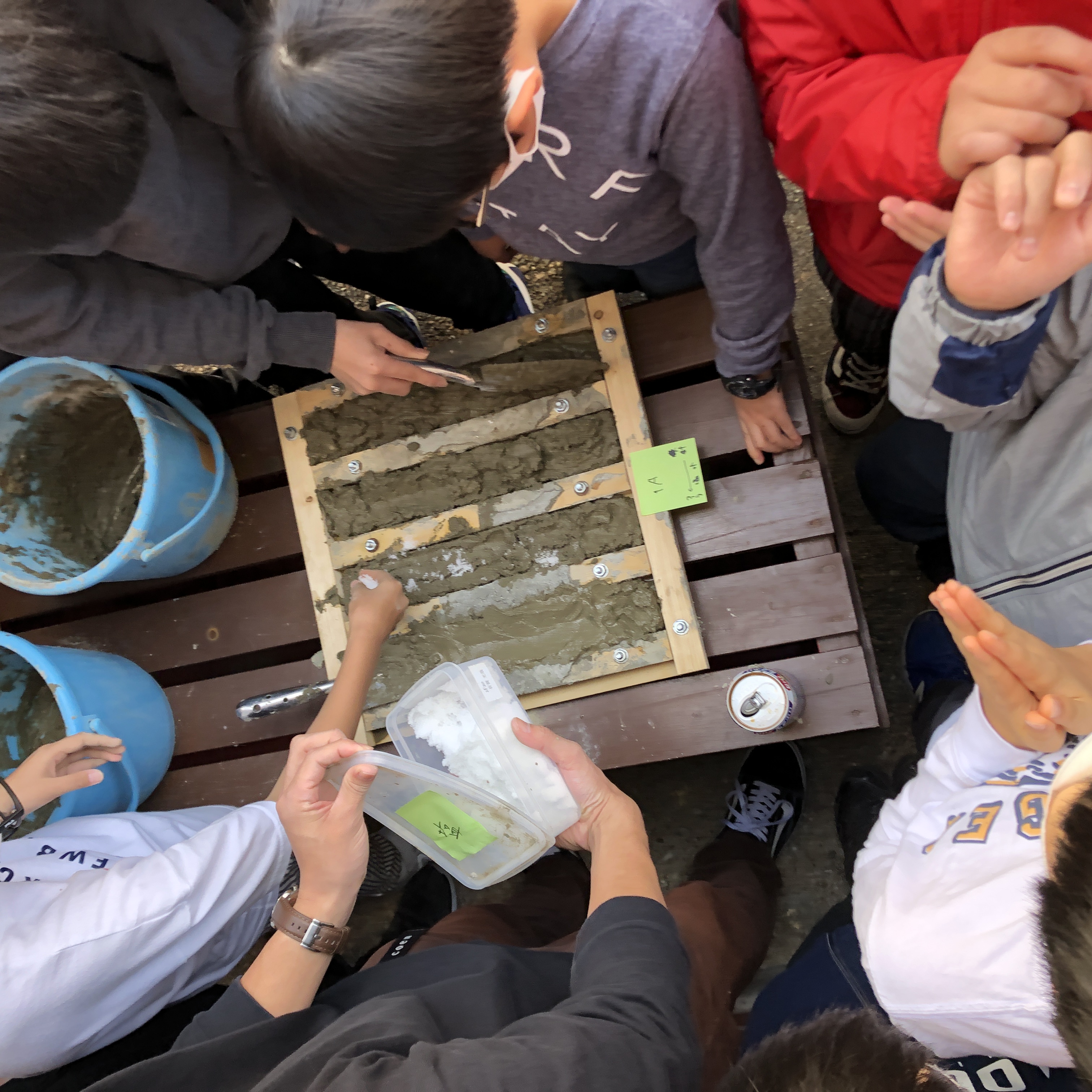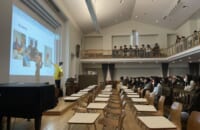モルタル・セメントを練る経験は未来のインフラや街づくりを考える貴重な経験となる
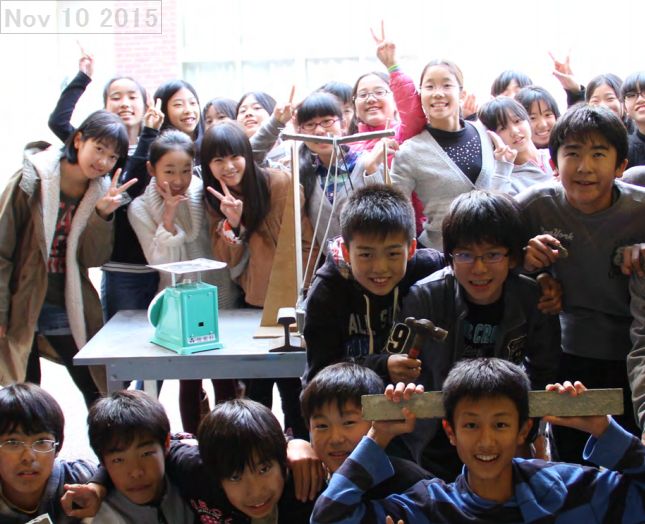
未来の社会インフラを自分事として認識し、解決策の考案にコミットしていくための確かかな経験
みなさんはモルタルという言葉を聞いたことはありますか?それはよくコンクリートと区別することなく使われることが多いです。コンクリートは、セメント+砂+砂利で作られ、大きな圧縮力に耐えることができます。モルタルは、コンクリートから砂利を引いたもの、すなわちセメントと砂で作られたもので、見栄えはコンクリートよりもきめ細かくて美しく見えることから、コンクリート構造物の表面にはモルタルでカバーすることが多いです。従って、私たちが目にしているコンクリートとは実はモルタルであると言えます。
作り方は意外と簡単にできます。砂とセメントと水を混ぜ合わせ、型に流し込み化学反応で固まるのを待つだけです。(メーカーの設計通りの強度を引き出すことはそう簡単ではありません。製作過程の厳しい管理が必要になります)
強度試験を行うため4種類のテストピース(50センチの長さのピース)を用意します。
一つ目は、セメント+砂+水と、鉄骨に見立てた針金を中に埋め込みます。モルタルやコンクリートは引っ張りの力に弱いので、それを補うために引っ張りの力に対して強い耐力がある鋼の針金を用います。また、酸性に弱い鋼は、アルカリ性のコンクリートによって守られることになるので、お互いの弱点を支え合っています。鋼とコンクリートは最高のパートナーとも言えます。
二つ目は、セメント+砂+水のみで、鋼の針金はありません。
三つ目は、セメント+砂+水のなかに、不純物が混じってしまう状況を想定して塩を加えます。これは、浜辺の砂など十分に成分管理されていない材料を骨材として使ってしまったケースを想定しています。「手抜き工事」と言われるものです。
四つ目は、セメント+砂+水の中に、コーラを入れます。これは作業員が飲んでいるジュースをこぼしてしまったというハプニングを想定しています。
本日は、生徒がそれぞれモルタルを練って型枠に流し込みました。次回の授業で強度試験を行います。どのような結果を得ることができるか、私たちは楽しみにしています。
ところで、この教育的な活動のゴールは、生徒たちは私たちの町の社会インフラを自分事として考え、未来の社会資本を維持発展について考えるきっかけを獲得することにあります。
私たちの社会インフラの多くは、コンクリートで作られています。それらは数十年経過すると老朽化し、補修工事が必要になってきます。それは市や国の財政を圧迫することを意味します。新しいインフラを作れば、それは同時に未来にたいして快適さを与えるとと共に負荷を同時に与えるものでもあるのです。
私たちは、人と人とがつながって豊かな社会生活を築いていくために、社会インフラを維持していく方法を考えて行かなくてはなりません。この教育的な活動をきっかけにして、未来の社会資本や社会インフラの問題に一人ひとりがコミットしていくマインドを獲得することをゴールに設定しています。(沼田)
【参考資料】
#1 What’s the difference between Mortar and Concrete?
https://jhs.js.doshisha.ac.jp/headline/mortar2019/
#2 オリジナルテキスト
https://jhs.js.doshisha.ac.jp/wp-content/uploads/2020/10/Mortar_handout2020.pdf
#3 記事 「モルタルを打ち込む」
https://jhs.js.doshisha.ac.jp/wp-content/uploads/2017/11/omosiro_morutaru.pdf
#4 社会資本の未来を自分ごととしてとらえる授業
http://ur0.work/EsVv
#5 『新 技術科の授業を創る:子どもの学びが教師を育てる』
拙稿「社会資本を自分ごととしてとらえる」
学文社 https://www.gakubunsha.com/book/b528217.html
AMAZON www.amazon.co.jp/dp/4762030244
#6 Kazyta Numata An In-depth Understanding of Infrastracture through the bridge contest
https://jhs.js.doshisha.ac.jp/wp-content/uploads/2020/08/7ed452fc773fbce5f787385b0718e643.pdf
An educational activity of Mixing mortar and cement will be a precious experience for thinking about future infrastructure and sustainable development of urban development.
An activity to get students to take ownership of the common problem and find the right solution for our future –
Have you ever heard of the word mortar? But you know concrete. We sometimes can not distinguish between the two. Concrete is made of cement + sand + gravel and can withstand large compressive forces. Mortar is made by subtracting gravel from concrete, that is, made of cement and sand, and because it looks finer and more beautiful than concrete, the surface of concrete structures is often covered with mortar. Therefore, it can be said that the concrete we see is actually mortar.
It’s surprisingly easy to make. All you have to do is mix sand, cement and water, pour it into a mold and wait for it to harden in a chemical reaction.(It is not so easy to bring out the strength as designed by the manufacturer. It requires strict control of the manufacturing process.)
Prepare 4 types of test pieces (pieces with a length of 50 cm) for strength testing.
The first is to embed cement + sand + water and a wire that looks like a steel frame inside. Mortar and concrete are vulnerable to tensile force, so to compensate for this, use steel wire that has strong resistance to tensile force. Also, steel, which is sensitive to acidity, is protected by alkaline concrete, so it supports each other’s weaknesses. Steel and concrete are also great partners.
The second is only cement + sand + water, no steel wire.
The third piece is mixed cement + sand + water + salt. This is an assumed case where poor material was used as aggregate. For example, beach sand. It is called “corner-cutting work”.
The fourth piece is added soda that is made from cement + sand + water +”cola”. This assumes the happening that the worker has spilled the juice when he/she was drinking.
Today, each student kneaded mortar and poured it into the formwork. We will do a strength test in the next class. We are looking forward to seeing what the results will be.
By the way, the goal of this educational activity is to give students an opportunity to think about the social infrastructure of our town as their own and to maintain and develop future social capital.
Much of our social infrastructure is made of concrete. After decades, they become obsolete and require repair work. This creates financial strain to both the city and the country. Creating new infrastructure will simultaneously increase comfort and financial strain for the future.
We must think about ways to maintain social infrastructure in order to improve quality of life for city dwellers and promote municipal wealth. Through this small educational activity, we have set the goal of promoting an individualized sense of unique ownership of social investments in future social capital and civil infrastructure.
An educational activity of Mixing mortar and cement will be a precious experience for thinking about future infrastructure and sustainable development of urban development. (Numata)
[Reference material]
# 1 What ’s the difference between Mortar and Concrete?
https://jhs.js.doshisha.ac.jp/headline/mortar2019/
# 2 Original text (written in Japan)
https://jhs.js.doshisha.ac.jp/wp-content/uploads/2020/10/Mortar_handout2020.pdf
# 3 Article “Driving in mortar” (written in Japanese)
https://jhs.js.doshisha.ac.jp/wp-content/uploads/2017/11/omosiro_morutaru.pdf
# 4 Classes that capture the future of social capital as one’s own (written in Japanese)
http://ur0.work/EsVv
# 5 “Creating a new technical class: Children’s learning nurtures teachers”
I am one of the authors. (Written in Japanese)
Gakubunsha https://www.gakubunsha.com/book/b528217.html
AMAZON www.amazon.co.jp/dp/4762030244
#6 Kazyta Numata An In-depth Understanding of Infrastracture through the bridge contest
https://jhs.js.doshisha.ac.jp/wp-content/uploads/2020/08/7ed452fc773fbce5f787385b0718e643.pdf

